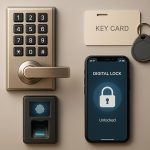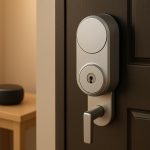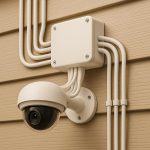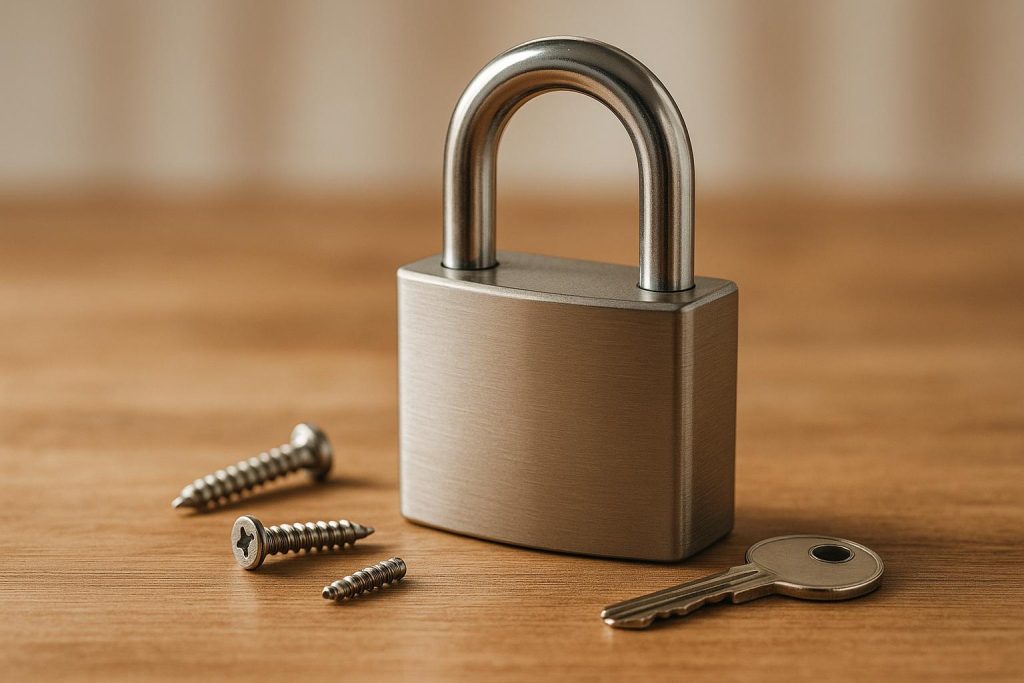When choosing budget locks, focus on balancing cost and security. Budget locks, like Grade 3 deadbolts or knob locks, are affordable and suit low-risk areas like interior doors. For exterior doors or higher-risk entry points, consider upgrading to Grade 2 locks for better protection. Assess your property’s entry points, usage, and local crime rates to determine your needs. Prioritize locks with features like anti-pick cylinders, bump-proof technology, and rekeying options for added security without overspending.
Key Takeaways:
- Front Doors: Use Grade 1 or 2 deadbolts (e.g., Schlage B60, $40–$60).
- Interior Doors: Grade 3 knob locks work well ($10–$25).
- High-Risk Areas: Invest in durable locks with added security features.
- Weather Resistance: Choose stainless steel or brass for outdoor locks.
- Professional Help: For complex installations, consult a locksmith.
A well-chosen lock paired with proper installation ensures safety without exceeding your budget. Start by securing the most vulnerable areas, and don’t hesitate to seek professional advice for tailored solutions.
How to Assess Your Security Needs
Check Entry Points and Usage
Take a walk around your property and note every access point: front door, back door, side entrances, garage doors, windows, and basement entries. Each of these has its own security challenges that need attention.
Front doors tend to be the first target for break-ins because they’re the most obvious way in. These should have your strongest locks. Back doors and side entrances, often hidden from view or poorly lit, can become easy entry points if overlooked. Garage doors are another weak spot – many people forget to secure them, even though they can lead straight into the house.
Think about how often each entry point is used. High-traffic doors like the main entrance need locks that can handle frequent use without wearing down. For instance, the Kwikset Juno deadbolt is a strong contender, as it performs well in Consumer Reports testing for both security and durability. On the other hand, doors that are rarely used, such as basement or storage room entries, might only need simpler Grade 3 deadbolts or slide bolts.
Visibility matters too. Entry points hidden from public view are more appealing to intruders because they can work unnoticed. Doors with glass panels near the lock are especially vulnerable – breaking the glass gives easy access to the lock mechanism inside.
Consider External Factors
Your neighborhood plays a big role in determining the level of security you need. In areas with higher crime rates, it’s smart to invest in stronger locks, like ANSI Grade 1 or 2 options. In quieter neighborhoods, Grade 3 locks might be enough for less critical entry points. Checking local crime data can help you make informed choices.
The type of property you live in also matters. Single-family homes typically have more entry points to secure, including garages and basements, while apartment dwellers may only need to focus on the main unit door.
Household dynamics are another factor. Families with children need locks that are secure yet simple enough for kids to operate in emergencies. For elderly family members, avoid complicated locking mechanisms and opt for straightforward deadbolts. If you’re a landlord, consider locks with rekeying features, like Kwikset’s SmartKey technology, which lets you change keys easily without needing a locksmith – a handy feature when tenants move out.
Finally, weather conditions can affect your choice of locks. Outdoor locks in areas with extreme temperatures or heavy rain need weather-resistant finishes to prevent rust and malfunction. Stainless steel and brass locks usually hold up better than zinc alloy in harsh climates.
Once you’ve factored in these external risks, you can start distinguishing between the needs for outdoor and indoor locks.
Interior vs Exterior Lock Requirements
Understanding the difference between locks for exterior and interior doors is key. Exterior doors need heavy-duty locks like ANSI Grade 1 or 2 deadbolts to resist kick-ins, picking, and drilling. Options like single or double cylinder deadbolts, smart locks, or Euro cylinder locks with anti-snap features are great for main entrances.
Interior doors, on the other hand, prioritize privacy over heavy security. Bedrooms and bathrooms typically need simple latch or knob locks that can be locked from the inside but are easy to open in emergencies. Grade 3 locks work perfectly for these.
For storage rooms, closets, or basement doors, the requirements fall somewhere in between. These spaces might need basic security to protect valuables but don’t require the same level of protection as exterior doors. In these cases, simple deadbolts or slide bolts are usually sufficient.
If you’re uncertain about what kind of locks to choose or have complex setups like multi-point locking systems, reaching out to experts like Sherlock’s Locksmith in Pittsburgh, PA, can be a good move. They can assess your property and recommend the best options for your security needs.
| Entry Point Type | Recommended Lock Grade | Typical Lock Types | Key Considerations |
|---|---|---|---|
| Front/Main Door | Grade 1 or 2 | Deadbolts, Smart Locks | High security, durable, weather-resistant |
| Back/Side Doors | Grade 2 | Deadbolts, Lever Locks | Adjust security based on visibility/use |
| Interior Doors | Grade 3 | Knob Locks, Privacy Locks | Easy operation, emergency access |
| Storage/Utility | Grade 3 | Deadbolts, Slide Bolts | Basic security, cost-efficient |
Lock Types and Security Grades Explained
Common Lock Types and Their Uses
Deadbolts are a solid choice for resisting forced entry and are relatively affordable, with prices starting at $20–$40. The most common type is the single-cylinder deadbolt, which uses a key on the outside and a thumb turn on the inside. A popular model like the Kwikset 660 features SmartKey technology, allowing for quick rekeying. For stronger protection, consider the Schlage B60 Single-Cylinder Deadbolt, which boasts an ANSI Grade 1 rating and typically costs between $40 and $60.
Knob locks are a budget-friendly option, usually priced from $10–$25. While they’re not ideal for exterior doors due to their vulnerability to forced entry, they work well for interior spaces like bedrooms, bathrooms, or storage areas where privacy is the main concern.
Lever handle locks are commonly seen in commercial spaces and multi-family apartments because they’re easy to use. These locks range from $20 to $50 and offer security comparable to knob locks, depending on their ANSI grade. However, their design can be more susceptible to forced entry unless reinforced with anti-tamper features.
Keypad and smart locks are becoming more accessible, with basic models starting at $50 and advanced ones reaching up to $150. These locks eliminate the need for physical keys, which is particularly useful for those who frequently lose keys or need to grant temporary access. For example, the Kwikset SmartCode 915 TRL provides keyless entry at an approximate cost of $80.
Understanding these lock types is an essential first step before diving into the ANSI/BHMA security grading system.
ANSI/BHMA Security Grades

The American National Standards Institute (ANSI) and Builders Hardware Manufacturers Association (BHMA) have created a grading system to evaluate locks based on durability, strength, and resistance to forced entry. Locks are classified into three grades:
Grade 1 locks are the most robust, designed to endure 10 strikes of 75 pounds of force. They’re ideal for high-security needs and high-traffic areas. Although they cost more initially, they offer unmatched durability and protection.
Grade 2 locks provide a balance between security and affordability, making them a popular choice for residential exterior doors. They’re a practical option for homeowners seeking reliable protection without overspending.
Grade 3 locks are the most economical and can withstand 2 strikes of 75 pounds of force. These locks meet the minimum standards for residential use and are well-suited for interior doors, storage rooms, or low-risk exterior doors like those leading to fenced backyards.
For exterior doors, a Grade 2 lock is a solid choice, but if your budget allows, opting for a Grade 1 lock offers superior security. For interior doors, Grade 3 locks are generally sufficient as they prioritize privacy over break-in resistance.
Features to Look for in Budget Locks
Even if you’re shopping on a budget, many locks come with features that enhance security:
- Anti-pick cylinders make it harder for intruders to pick the lock, offering an added layer of protection for just a bit more cost.
- Bump-proof technology protects against lock bumping, a method where specially made keys are used to force open standard locks. Many budget-friendly models now include this feature by default.
- Reinforced strike plates can dramatically increase a door’s resistance to kick-ins – some models can withstand up to 800 pounds of force . For example, the Prime-Line Security Lock, priced around $20, offers this level of durability .
- Rekeying capabilities, such as Kwikset’s SmartKey technology, let you quickly change the key that operates your lock without needing a locksmith. This is particularly helpful for landlords or anyone concerned about unauthorized key duplication.
- Budget-friendly keypad locks often include features like auto-locking mechanisms and access logs, which ensure your door locks automatically after a set time and allow you to track who has accessed it.
When considering budget locks, always check the ANSI/BHMA grade and look for these added features. Reading reviews from reliable sources like Consumer Reports can also help you identify models that deliver on their promises. For instance, Consumer Reports highlighted that the Eufy Smart Lock Touch & WiFi S230 performed well against picking and kick-in attempts, while the MiLocks BLEF-02SN did not fare as well.
The table below summarizes the key details about the lock types, their uses, security levels, and price ranges:
| Lock Type | Best Use | Security Level | Price Range | Key Features |
|---|---|---|---|---|
| Deadbolt | Exterior doors | High (Grade 1–2) | $20–$60 | Anti-pick, bump-proof, rekeying |
| Knob Lock | Interior doors | Low–Medium (Grade 2–3) | $10–$30 | Easy installation, privacy |
| Lever Handle | Interior/commercial | Medium (Grade 2–3) | $20–$50 | ADA compliant, easy operation |
| Keypad Lock | Exterior/interior | Varies (Grade 1–3) | $50–$150 | Keyless entry, access codes |
How to Compare Budget Lock Options
Budget Lock Comparison Table
Here’s a quick breakdown of popular budget-friendly locks, highlighting their features, pricing, and ideal uses:
| Lock Model/Type | Price Range | Security Features | Pros | Cons | Best For |
|---|---|---|---|---|---|
| Aqara U50 | ~$100 | Apple Home Key, touchscreen | Affordable smart features, easy setup | Limited to Apple ecosystem | Budget smart home users |
| Eufy E30 | ~$120 | Wi‑Fi, Matter, fingerprint | Versatile connectivity, good value | Not Apple Home compatible | Tech‑savvy users |
| Yale Assure | $149–$199 | Keyless, PIN, app, Z‑Wave/Zigbee | Trusted brand, flexible integration | Higher price for full features | Homeowners |
| Kwikset Kevo | $199 | Bluetooth, keyless entry | Easy operation, key/phone options | Only fits standard doors | Renters, homeowners |
| Basic Magnetic Lock | $5–$25 | Simple keyless mechanism | Very cheap, easy installation | Low security, not for valuables | Cabinets, child safety |
| Cylinder Lock | $15–$50 | Pin tumbler, keyed access | Durable, pick resistant | Risk of lost keys, higher cost | Safes, offices |
From this table, it’s clear that smart locks like the Aqara U50 and Eufy E30 deliver modern features at a reasonable price, while traditional mechanical options like cylinder locks provide basic security at a lower cost.
Key Factors When Comparing Locks
The comparison table is just the starting point. Here are some important considerations to keep in mind when evaluating budget locks:
- Performance in Testing: Consumer Reports highlights significant differences between locks in the same price range. For example, the Eufy Smart Lock Touch & Wi‑Fi S230 scored highly for resistance to kick-ins and picking, while the MiLocks ZWF‑02BN performed poorly, being vulnerable to drilling, picking, and forced entry.
- Door Compatibility: Most budget locks work with standard door thicknesses (1‑3/8″ to 1‑3/4″), but some models may need adapters or special kits. For instance, the Kwikset Kevo is only compatible with standard doors, which could be problematic for older homes with non-standard measurements.
- Ease of Installation: Opting for a DIY-friendly lock can save on installation costs. The Prime-Line Security Lock, for instance, is a renter-friendly option that’s easy to install without causing damage to the door.
- Warranty Coverage: Look for locks with solid warranties that cover both mechanical and electronic issues. A good warranty can save money if the lock malfunctions within the first few years.
- Customer Reviews: Real-world feedback can reveal potential issues like sticking keys, electronic failures, or premature wear. These problems can turn an affordable lock into an expensive hassle.
- Brand Reputation: Established brands like Schlage and Kwikset are often more reliable than lesser-known manufacturers. Schlage is known for its durability and security, while Kwikset balances affordability with functionality.
The price-security relationship isn’t always straightforward in the budget category. As Sherlock’s Locksmith explains:
"The cost of a lock is likely to go up the more sophisticated and secure it is".
That said, some budget locks exceed expectations, while others fail to deliver even basic protection despite reasonable pricing.
For more complex decisions involving compatibility or security, it’s worth consulting a professional. In Pittsburgh, PA, Sherlock’s Locksmith offers expert advice and 24/7 mobile services for lock selection, installation, and emergencies. This ensures your budget lock choice aligns with your security needs and preferences.
Expensive vs Budget Door Lock – Do You Have to Spend Extra to Get Extra Security?
sbb-itb-643e28e
Selection and Installation Tips
Making the most of a budget-friendly lock starts with choosing one that fits your door and installing it correctly. Even a well-made lock can fail if it’s incompatible with your door or improperly installed.
Check Door Compatibility
Before buying a lock, measure your door carefully. You’ll need to know the material, thickness (usually between 1-3/8″ and 1-3/4″), backset (commonly 2-3/8″ or 2-3/4″), and borehole diameter (typically 2-1/8″). These details ensure the lock will fit properly.
Wooden doors are the easiest to work with, while metal and fiberglass doors might require special tools like specific drill bits. Some budget locks come with installation kits that include templates and guides, making the process easier. Always double-check these specifications in the product manual.
If you’re installing an outdoor lock, don’t forget to confirm it’s built to handle exposure to weather.
Weather Resistance for Outdoor Locks
When it comes to outdoor locks, durability is key. Stainless steel or brass locks are great options because they resist rust and wear. Look for locks labeled as weatherproof, and keep them in good shape with occasional cleaning using mild soap and water. Applying a graphite or silicone lubricant can also help maintain smooth operation.
Extreme temperatures can cause parts of the lock to expand or contract, which might lead to sticking or misalignment. High-quality outdoor locks are designed to handle these changes without losing functionality.
If your door setup is unusual or you’re dealing with harsh environmental conditions, it might be time to call in the experts.
When to Call a Locksmith
Sometimes, professional installation is the best choice – especially if you’re working with non-standard doors, have complex security needs, or simply want to ensure the job is done right. Certain situations call for expertise beyond DIY efforts.
For example, Sherlock’s Locksmith recently demonstrated the value of professional service by replacing a broken lock quickly and efficiently.
"Whether you need a new lock installed on a door or some more complex work requiring specialized knowledge of security systems, our team is here to help you get the job done right." – Sherlock’s Locksmith
Based in Pittsburgh, PA, Sherlock’s Locksmith offers 24/7 mobile services with certified technicians who follow the latest industry standards. Their skilled approach ensures installations are done carefully, minimizing potential damage to your locks or doors.
"We use reliable tools and techniques to ensure our locksmith services are performed to the highest standards. This attention to detail helps minimize potential damage to locks or doors during emergencies." – Sherlock’s Locksmith
Hiring a licensed and insured locksmith is often a worthwhile investment. It ensures proper security, reduces the risk of lock failure, and keeps your installation compliant with local building codes. Pairing a well-chosen lock with expert installation guarantees peace of mind and long-term reliability without stretching your budget.
How to Balance Security and Budget
Finding the right balance between security and cost means focusing your resources on the most vulnerable areas. It’s all about making informed decisions on where to spend and understanding what each dollar brings in terms of protection.
Set a Realistic Budget
Start by listing all the doors in your home and ranking them based on risk. For high-risk areas like the front door, back door, or garage, plan to spend $40–$80 on Grade 1 deadbolts. For interior or low-risk doors, a budget of $10–$30 for Grade 3 locks should suffice. Don’t forget to include installation costs in your calculations.
Professional installation can be a significant expense, with full-service jobs costing around $450. If you’re tackling a more complex installation, be sure to account for labor costs. Prioritize your budget to cover high-risk entry points first, then allocate remaining funds for less critical areas.
Focus on High-Security Areas First
Testing from Consumer Reports has shown that premium locks outperform cheaper models when it comes to resisting forced entry methods like kick-ins, drilling, and picking. For example, the Kwikset Juno 991J15SMTCP deadbolt excelled in forced-entry resistance, while budget smart locks such as the MiLocks BLEF-02SN failed under brute force testing.
This highlights the importance of spending strategically. Invest in top-quality locks for your main entry points. For instance, a Schlage Encode with Grade 1 security, priced at $300–$350, is a solid choice for a front door. Meanwhile, a Kwikset 660 deadbolt, offering Grade 3 security for $30–$40, works well for interior doors or lower-risk areas.
For high-risk doors, single-cylinder deadbolts or Euro cylinder locks with anti-snap features are excellent options. These usually cost $30–$70 and provide much better security than basic knob locks. By focusing your spending on the most critical areas, you ensure strong protection where it matters most.
Calculate Long-Term Value
Initial costs are only part of the equation – durability and efficiency over time are just as important. High-quality locks not only last longer but also require less maintenance, saving you money in the long run. Insurance companies often recognize this, offering 5–15% annual discounts on homeowners’ policies for homes equipped with certified high-security locks like Grade 1 deadbolts or advanced smart locks.
Features like smart rekeying, found in the Kwikset 660, can also save you money. This feature allows you to rekey the lock yourself in seconds, avoiding locksmith fees whenever you need new keys. Over the lifespan of the lock, this convenience can add up to hundreds of dollars in savings.
Weather resistance is another factor to consider. Locks made from stainless steel or brass may cost more upfront, but they’re less likely to rust or fail, reducing replacement costs over time.
For tailored advice, consider consulting professionals like Sherlock’s Locksmith in Pittsburgh, PA. Their certified technicians can evaluate your specific needs and recommend cost-effective solutions for each entry point. Expert guidance can help you avoid costly mistakes, such as choosing incompatible locks or overlooking key security features.
Smart budgeting means looking beyond today’s price tag. Consider the total cost of ownership, including maintenance, insurance savings, and the reassurance that comes with a well-secured home.
Conclusion: Secure Your Property on a Budget
Protecting your property doesn’t have to break the bank. By carefully selecting budget-friendly locks that meet your specific needs, you can achieve effective security without overspending. Start by considering ANSI/BHMA security grades, focusing on high-risk entry points, and choosing locks with proven performance.
Affordable locks can provide reliable protection when chosen wisely. Real-world testing shows that even lower-cost options can deliver solid security if they meet critical standards. For instance, some inexpensive locks, like the MiLocks ZWF-02BN, have vulnerabilities such as susceptibility to drilling and picking, which highlights the importance of making informed decisions.
Seeking professional advice can simplify the process. For those in Pittsburgh, PA, Sherlock’s Locksmith offers expert consultations to help you find cost-effective yet dependable solutions. Their certified technicians can evaluate your needs and recommend locks that balance security and budget.
Achieving strong security on a budget is entirely possible. Prioritize spending on areas that require higher protection, choose locks with verified ratings, and consult experts when needed. By following these steps, you can safeguard your home effectively and economically.
FAQs
What’s the difference between Grade 1, Grade 2, and Grade 3 locks, and how do I choose the right one for my home?
Locks are categorized by their durability and security levels, as outlined by the American National Standards Institute (ANSI). Here’s a quick breakdown:
- Grade 1: These locks offer the highest security and durability, making them a solid choice for commercial properties or areas with higher security risks.
- Grade 2: A step down from Grade 1, these locks strike a balance between security and affordability, making them ideal for most residential homes.
- Grade 3: These are the most basic and budget-friendly locks, typically used for interior doors or spaces with minimal security needs.
When deciding on a lock, think about how much security the area requires. For exterior doors or places needing stronger protection, Grade 1 or Grade 2 locks are the way to go. On the other hand, Grade 3 locks work well for interior doors or areas with lower security concerns. If you’re unsure, a professional locksmith can help evaluate your specific situation and guide you toward the best option.
How can I make sure my outdoor locks are strong and weatherproof enough to handle tough conditions?
When it comes to outdoor locks, durability is everything. To ensure they can handle tough weather conditions, opt for locks made specifically for outdoor use. Materials like stainless steel and brass are top choices because they naturally resist rust and corrosion. For extra protection, look for locks with weatherproof seals or special coatings designed to keep the elements at bay.
Don’t forget about upkeep! Regularly cleaning the lock and applying a weather-resistant lubricant can go a long way in keeping it working smoothly. If you’re not sure which lock suits your needs best, a professional locksmith can guide you in choosing and installing the perfect option for dependable, long-term use.
What should I consider when choosing affordable locks to keep my property secure?
When you’re shopping for budget-friendly locks, focus on three key factors: durability, security features, and compatibility with your property. Opt for locks made from sturdy materials like hardened steel or brass, as they offer greater resistance to tampering and wear. Pay attention to features like anti-pick mechanisms, drill resistance, and deadbolts – these can significantly boost security without breaking the bank.
It’s also important to choose a lock that suits your specific requirements, whether it’s for a front door, a storage unit, or a gate. If you’re unsure about the best option, consulting a professional locksmith can help you strike the right balance between affordability and security.









